How and Where Do You Find Truffles? A Detailed Guide.
The search for truffles is certainly one of the most fascinating aspects of the mushroom. Growing truffles is very difficult and often does not bring the results one hoped. For this reason, the search on different truffle soils is still the most used way to collect the precious underground mushroom. Finding truffles is not easy, there are very strict regulations to protect this gift of the earth.
If you are interested and want to start roaming the woods or you are already an experienced truffle collector looking for new advice. This guide will show you how to find truffles and respect the dog, nature and other truffle collectors.
A short summary of how to find truffles:
- Participation in training courses
- Obtaining an entitlement card
- Purchase of the appropriate tools
- Training of a truffle dog
- Research into national and regional regulations
- Know the harvest times
- Knowing the dangers of the forest
- Choosing the most suitable terrain for your search
- Recognition of the signs of truffles
- Understanding the behavior of dogs in search
- Know the differences of symbiotic plants
Table of Contents
- What You Should Know Before You Start Looking For Truffles
- The Profession of a Truffle Hunter (Trifolau)
- The Regulations
- The Allowed Truffles and the Harvesting Periods
- The Right Environment for Truffle Hunting
- Practical Tips for the Truffle Search
- The Nocturnal Truffle Search
- Where do you Find Truffles in Italy?
- Where to Find the Different Types of Truffles
What You Should Know Before You Start Looking For Truffles
Before you can set out in search of truffles, you must pass an examination and receive an appropriate authorization card. This is to preserve the spontaneous nature of the precious mushroom and so that no inexperienced people can endanger its delicate development. You must be aware of the rules which come into force when searching, you must also know which dog is most suitable for the collection of truffles, one must also know that having a truffle searching dog is required by law and must be used to find the precious truffle
In order to be able to go looking for truffle one must therefore become a licensed truffle hunter.
The Profession of a Truffle Hunter (Trifolau)
The Trifolau is a figure that has been shrouded in mystery since its creation. Truffle collectors know their forests in the smallest detail, they know the soil, the plants and the secret places where the precious truffles grow. Traditionally they wander around at night, without light and only in the company of their faithful dogs. They share their secrets only with close relatives and brotherly friends, their wisdom represents a true small heritage of the land.
The profession seems to be a rather relaxed one, but it is governed by clear obligations, and there is no room for improvisation. To become a truffle collector, you must be at least 14 years old:
- You must also attend special training courses organized by the regions of each province. In the course, a future truffle collector learns the delicate balances that affect the truffle ecosystem and how to preserve them. The course also teaches how to recognize the different truffle species.
- At the end of the course an exam must be taken to test the theoretical knowledge.
- After passing the exam, you can claim an entitlement card in your respective region, the payment of a fee will allow you to collect truffles throughout the national territory. The fee must be paid annually, the card is valid for five years and can be renewed for another five after the five years are over.
The knowledge of an experienced Trifolau naturally goes far beyond the essential theoretical knowledge taught in the courses. Over time, a truffle collector acquires a number of skills, he learns to recognize the symbiotic plants of the different truffle species. In addition, he learns to orientate himself in the different terrains to make his search much easier. It is then essential (obligatory) to train a dog and to build up a relationship of trust, respect and empathy with him on their search.
The Truffle License
In order to obtain a permit for truffle hunting, you must register with the UTR (regional authority) in your province of residence. The card is valid for five years from the date of issue. You can only obtain it if you are over 14 years old and have passed the relevant examination. A fee must be paid each year.
The location and date of the exams can be requested from the UTR at any time, this also applies to information about training courses. Courses are organised by the park administrators and municipalities. During the course you can learn how to recognize and search for truffles, while respecting the legal regulations.
The aptitude test can not be underestimated, if you do not pass it, it can be repeated only twelve months later.
The tools of the Truffle Collectors
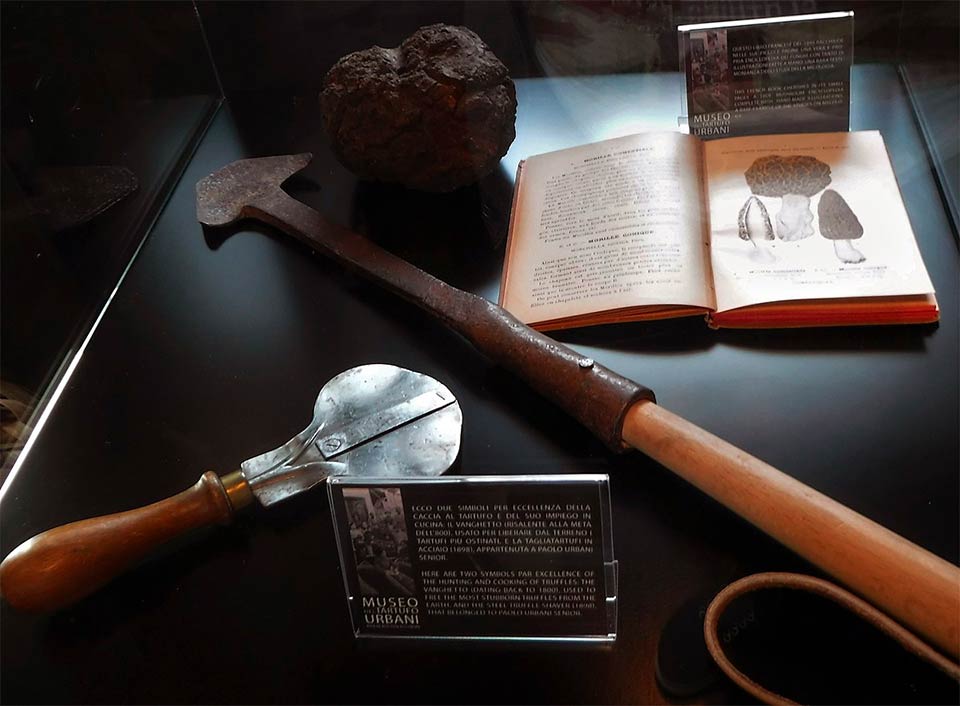
The Italian law prescribes some special tools for a truffle collector to dig out the precious mushroom. These tools include the spade (truffle collector's spade), a small hoe that is used to damage the soil and the delicate roots of the mushroom as little as possible. Once the truffle is extracted from the ground, the hole must also be filled with soil to allow the growth of new truffles.
Also for transporting the truffles you need special tools: either the typical truffle bag made especially for truffles or a vest similar to those used by mushroom pickers. It is recommended to wear knee-high boots as well as appropriate clothes to protect yourself against thorns, stinging insects and snakes. A truffle collector should also always carry gloves for safe digging, a stick and first aid ointments.
The Truffle Dog
Originally pigs were used to find truffles, pigs have a very good sense of smell and can easily locate the underground mushrooms. But the pigs have a disadvantage: they are greedy and eat the truffle which they find immediately. Nevertheless, they were of great importance for their efficiency and sense of smell in the search for truffles.
Pigs were first replaced by dogs on the noble farms: man's faithful and tame friend was considered much more elegant and refined in his search. The aristocrats also used dogs to entertain their distinguished guests. The use of the dog spread quickly and so the pig was used less and less.
Today the law forbids the use of pigs, because the animal causes a lot of damage to the ecosystem during its excavation work. The use of dogs is obligatory, as this is the only animal that can find the exact location of the truffle without digging around unnecessarily, thus not damaging the soil.
In Italy, the law stipulates that the dog must be specially trained for truffle hunting. A trained truffle sniffing dog is therefore indispensable and the training is not cheap, a well-trained dog can quickly cost up to 5000 Euros. However, it is not compulsory to buy an already trained dog or to contact a professional dog handler. With a lot of care and patience it is possible to train a dog yourself, if the dog is a puppy you start with simple games which slowly become more complex exercises.
Generally speaking, any dog with a good nose is suitable for truffle hunting, but also qualities such as intelligence, concentration, endurance and devotion are of great importance. Because a dog needs all of this to be able to master his training and to prove himself a good truffle sniffer dog.

However, tradition sees some breeds as the best when it comes to finding truffles, these are as follows:
- The Bracco Italiano
- The Pointer
- The Spinone Italiano
- The Cocker
- The Jack Russel
- The Griffon
- The Lagotto Romagnolo
Depending on the nature of the environment in which they are searching, truffle collectors use one specific breed instead of another. In the Tuscan and Markesan Apennines, the Bracco and Pointer are preferred. In Emilia, between Ferrara and Ravenna, the Lagotto is widespread, with its short nimble steps and always ready to be recalled by its owners. Very often you can also meet dogs of mixed breeds from small to medium size. These dogs are very impressive with their sense of smell and high resistance to fatigue and disease. The Lagotto Romagnolo, the only breed that is considered to be specialized in truffle hunting, is worthy of special mention.
The Regulations
The search for truffles is regulated at national level by Law 752/1985. This law allows the search in the forests and on uncultivated land and this is also free of charge. However, at the same time, obligations and prohibitions come into force, which aim to preserve the truffle as a natural heritage of the land. Let us go into detail:
- Possession of an authorization card for the search for truffles
- A truffle tracking dog must always be accompanied during the search
- The digging of truffles is only possible with a special truffle spade
- It is forbidden to work the soil in any way during the harvesting season
- The collection of unripe truffles is prohibited
- It is forbidden to leave holes open that have been dug out
- In general, it is considered forbidden to search for truffles at night, especially between one hour after sunset and one hour before sunrise. In Liguria, Lombardy and Piedmont this ban is lifted by regional laws, where truffles may be searched for, at any time of day.
- The sale of fresh truffles is forbidden outside the harvest season
- In general, the collection of truffles over two kilograms is prohibited, unless a regional law states otherwise.
In addition, the search and collection of truffles is forbidden in nature reserves, mycological areas and in newly afforested areas it is forbidden to search for truffles for a time limit up to 15 years. Some regions have also established their own restricted zones where truffles cannot be searched. It is also advisable to leave unripe or rotten mushrooms in the ground, as they are not only inedible but also contribute to the growth of new truffles.
Finally, as mysterious and fascinating as truffle gathering at night is, and as many would like to experience it, one must still be aware that it is strictly forbidden in most regions.

The Allowed Truffles and the Harvesting Periods
The law clearly defines which types of truffles may be harvested and sold. There is a rough time schedule with the periods in which the respective truffle species can be harvested. It is forbidden to harvest unripe specimens, as this prevents the underground fungus from multiplying. Here are the allowed species and the periods in which they can be harvested:
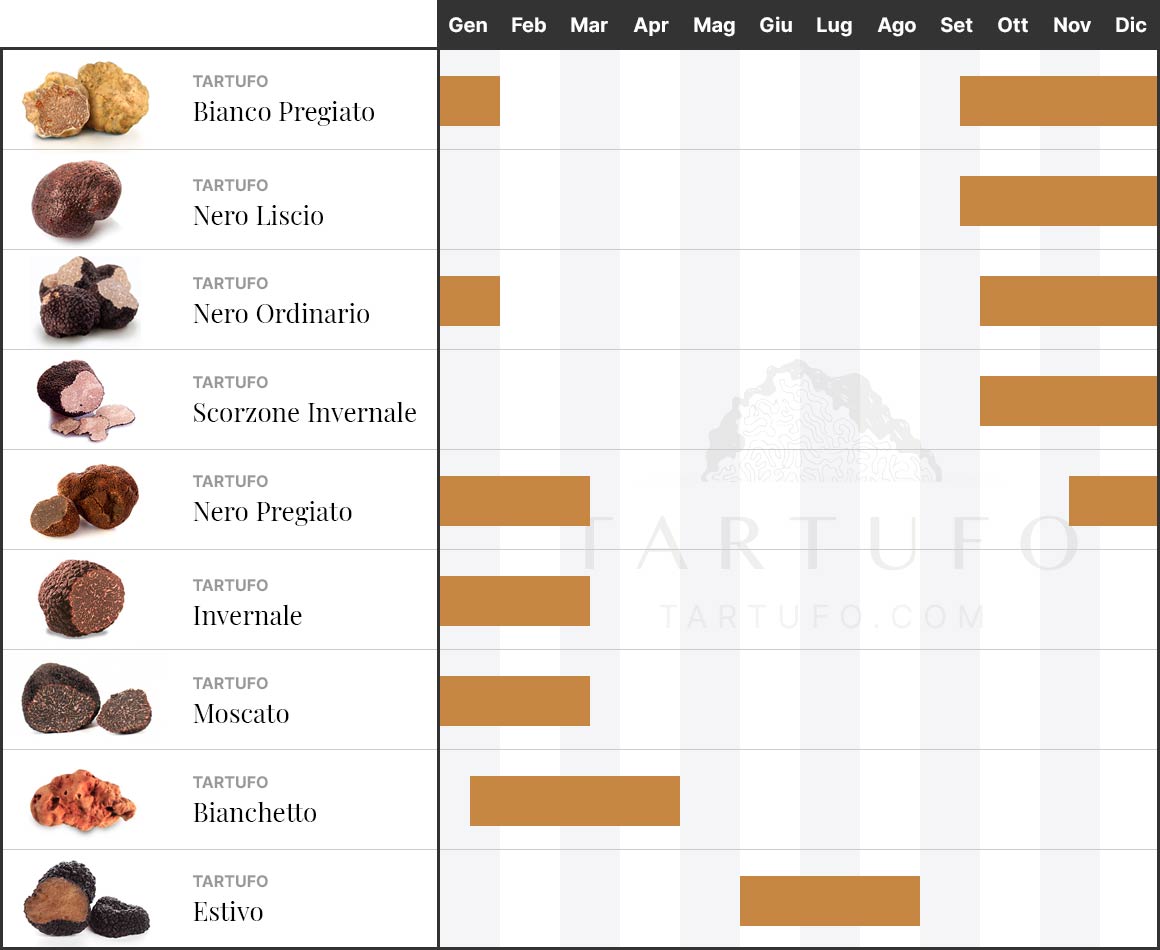
It should be noted that the periods for collecting truffles are those prescribed by national law. Regional legislation may provide for a different collection plan. In some cases, some provinces establish a schedule that takes into account the specific needs of the territories.
The Right Environment for Truffle Hunting
Most of the time, simple knowledge of which plants are symbiotic with truffles or in which areas (often near the surface in places with little vegetation) they occur, is not enough to achieve real success in collecting truffles. It is necessary to know the land and be able to avoid the dangers it brings. Here are some examples of dangers:
- Thorns and stinging plants
- Ticks
- Vipers
- Spiders and insects
- Waste and dangerous objects
In addition, it is an advantage to carry maps and a GPS device with you at all times to avoid loss of orientation. There is another even more underestimated danger: poisoned bait. Some truffle collectors wage wars against each other in which they aim at the dogs of the opponents.
In order for truffles to grow, the soil must have some chemical properties and a high degree of humidity. If one is ready to face the dangers of nature, then one must pay attention to the following when choosing the search location:
- An alkaline pH-level.
- Calcareous soil
- Which is well ventilated
- Without stagnation
Of course, these rules do not apply to all types of truffles, but these simple tips can help you understand where best to start with your search.
Practical Tips for the Truffle Search

The search for truffles is a complex activity, it requires a lot of experience and caution. It is difficult to learn how to search for truffles in a self-taught way: many truffle collectors are initiated by relatives into this centuries-old practice, thus preserving their family tradition. It is also necessary to have a detailed and in-depth knowledge of the woods in which one is searching, to recognize the land, plants and all the hidden signs that indicate the presence of the underground treasure. Without these years of experience, good results in the search are very unlikely.
- All black truffles, for example, release a substance from their spores that change the pH-level of the soil in such a way that it prevents the growth of other plants. Thus, an area is formed on the ground around the truffle where very few plants grow. These areas are called pianelli or witch circles, once it was believed that witches danced on these barren grounds.
- Organization and planning are also very important, you have to understand where to find truffles. Long trips in search of truffles are unnecessary and exhausting for both man and dog. The best place to look for truffles is in the surroundings of your home country, in order to explore this country in detail and with peace of mind. In this way, unnecessary disputes between the different truffle collectors can be fairly avoided.
- It is of great advantage to analyze the climatic events of the days before and after the harvest. These events have a great influence on the growth of the truffle. Rain, fog and strong winds all lead to a reduction in growth, and large mud formations should also be avoided. In addition, an analysis of the rainfall in recent months helps to find out which areas have benefited most from the climate and thus have achieved excellent truffle growth. For example, a summer that is too hot and with little rain delays the formation of white truffles, so it is better to choose an area where there was a lot of rain towards the end of the season*.
- We humans are not the only ones who love truffles. Unfortunately (or fortunately) there are numerous insects and animals competing for the precious fungus. But the competitors are not only a bad sign. Those who can recognize their traces will quickly find truffles, you just have to hope that the truffle has not already been devoured or used for other purposes. The pale suillia, also called truffle fly, for example, uses the truffles to lay eggs. However, in the search for the truffle, recognizing the presence and behavior of this fly is an important help.
*These are of course only indicative and partial data. There are so many other variables that influence the growth of the fungus and nature itself is often unpredictable. Nevertheless, these tips can help you in your search for truffles.
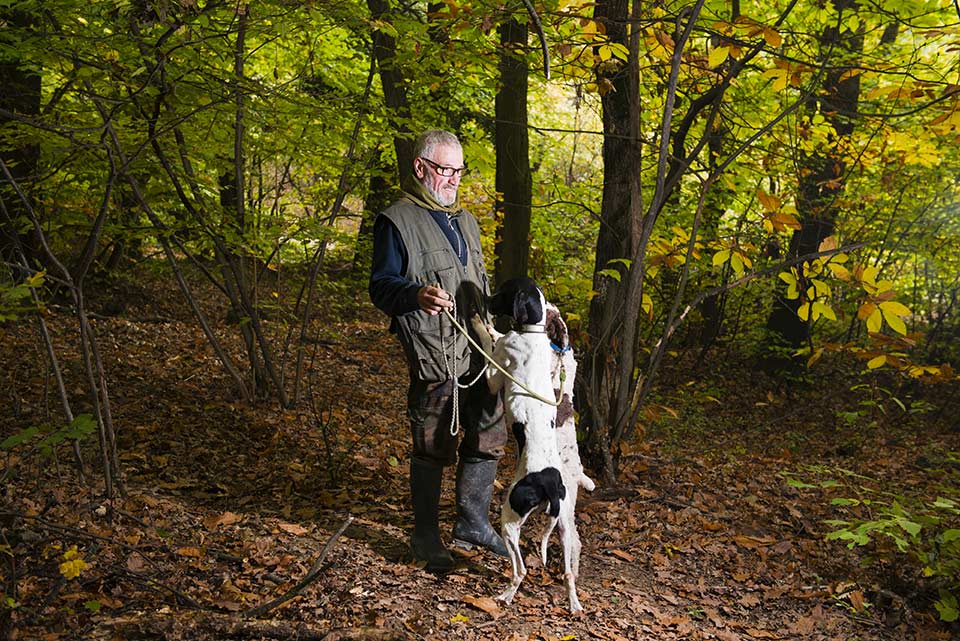
The Nocturnal Truffle Search
In the regions where this is allowed, many truffle collectors prefer to search at night, because the night helps them to keep their locations secret for the search. The night also helps the dog to search, he is more concentrated in the search, because the distractions are much smaller than during the day. Another advantage for the dogs: in the hours of dusk the humidity of the forest is increased, this makes the search for scent easier for the dog. But the search during the day is not to be underestimated, it allows you to have a deeper connection with the dog, the recall is easier, as well as the following of the dog when he has found a scent trail.
Where do you Find Truffles in Italy?
The truffle is a typical Italian product. Its culinary and gastronomic history, as we know it today began in Belpaese. Italy has the greatest variety and quantity of wild truffles. The place of choice to look for this truffle is undoubtedly in Piedmont, the region that has some of the best specimens and almost all edible varieties. Especially famous is the white truffle of Alba, the absolute excellence of Italian cuisine. Another area that is known for high quality truffles is the Apennine area in central Italy. the black truffles from Norcia originates from this region. The Po Valley and the southern Apennines are also areas that are known for their excellent quality truffles.
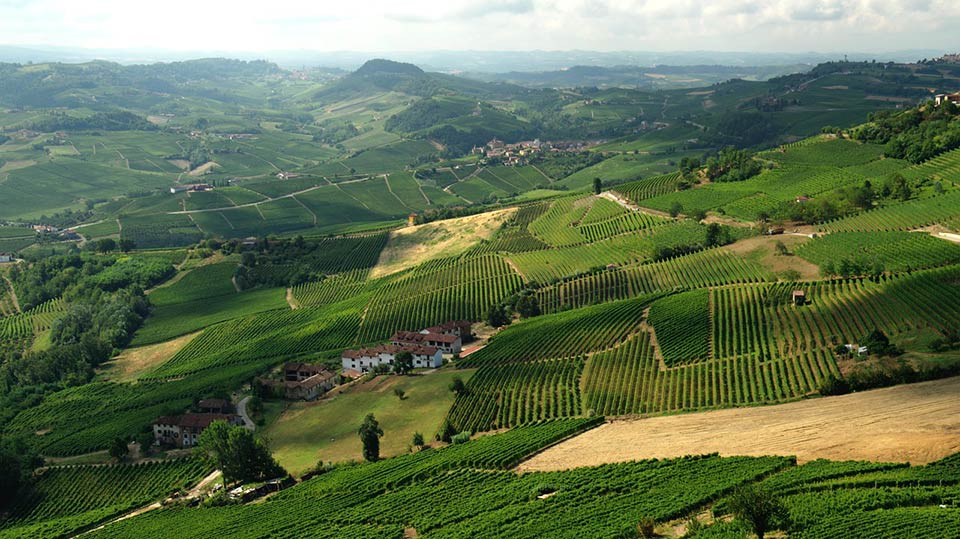
Where Can You Find Truffles in the Rest of the World?
Outside of the Italian border, truffles can be found in continental Europe, some countries in Eastern Europe and Southern England. In France, black truffles of high quality can be found in the Provence and the Périgord region, as well as in the province of Soria in Spain. Excellent white truffles, on the other hand, ripen in Romania, Bulgaria and above all in Istria, near the Italian border. In Mediterranean regions such as Turkey and North Africa, black summer truffles are commonly found. Beyond the borders of Europe truffles become a rare find; in the forests of Oregon high quality black truffles have been discovered, while in Canada, Russia, China and Japan they grow more sparsely.
Where to Find the Different Types of Truffles
Let's now go through the most important information about the geographical areas, soils and symbionts planting the main truffle species prefer to grow on:

Where Do You Find White Alba Truffle?
The White Alba Truffle, or Tuber Magnatum Pico, grows in the plains or hilly areas not higher than 700 metres above sea level. The truffle prefers well aerated with marl containing or calcareous soils, which are not excessively dry. Geographically, the precious mushroom is found especially in Langhe and Monferrato in Piedmont and the Apennines in central and southern Italy. Outside Italy, these high quality truffles grow in Istria. Among the symbiotic plants of this truffle are the oaks, willows, poplars, linden, hazelnut plants and black hornbeams.
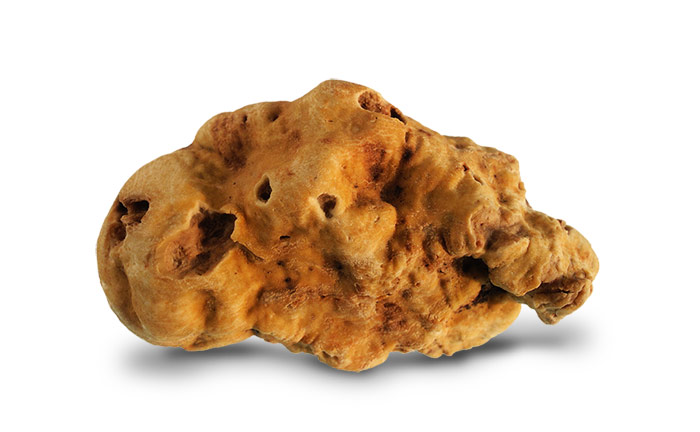
Where Do You Find Bianchetto Truffles?
The white truffle, also called Bianchetto Truffle or Tuber Borchii Vittadini, is very widespread both in Italy and in Europe. It develops on different types of soil, ranging from the coasts to the hilly and mountainous regions up to 1000 metres. In the Italian regions it is found mainly among the coniferous and deciduous forests near the coast. The host plants include the ubiquitous oaks, hornbeams, poplars, beech trees, hazelnut plants, willows, linden and various species from the pine family.
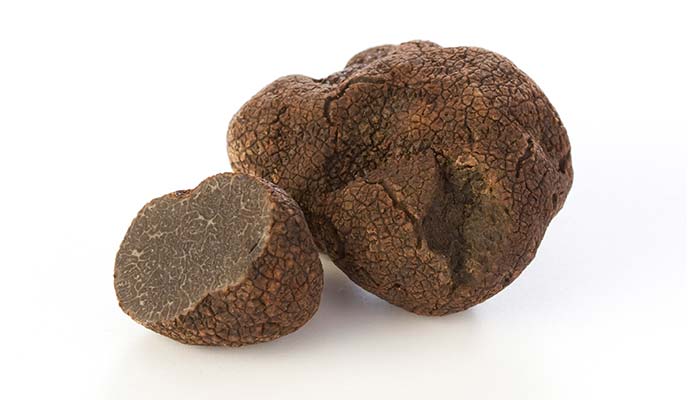
Where Do You Find Fine Black Truffle?
The fine black truffle or Tuber Melanosporum Vittadini, prefers a fertile soil in calcareous areas with a lack of organic humus. The symbiotic plants are usually sparse and they need a lot of sunlight. The black truffle is less rare than the white truffle, but is still difficult to find. The precious black truffle grows mainly in Piedmont, Marche and Molise. Beyond the Italian borders, the truffle grows in the Périgord region of France as well as in Spain and in the forests of Oregon. The black truffle grows under the foliage of oaks, black hornbeams, linden and hazelnut plants, in some cases even under the cistus roots.
On our site dedicated to the search of the precious black truffle, you can discover the most suitable regions, harvest times and the symbiotic plants in further detail.
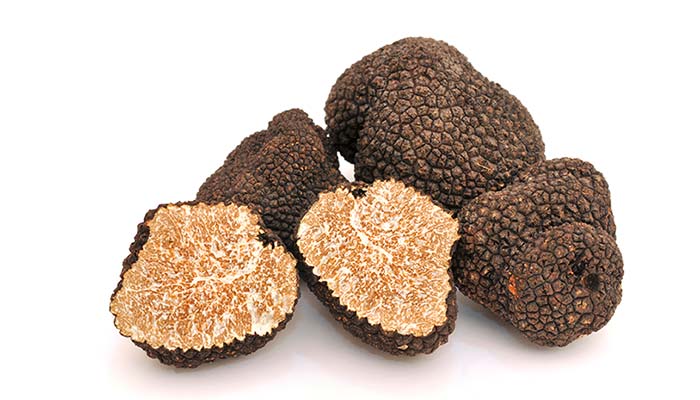
Where Do You Find Black Summer Truffle?
The black summer truffle or Tuber Aestivum Vittadini is a versatile species of truffle that appreciates both clayey and sandy soils, provided they are well aerated and have low humidity. This truffle can be found from the forests of Piedmont to the entire Apennine slopes. Outside Italy, the summer truffle can be found in France, Spain and generally in all countries with access to the Mediterranean basin. The summer truffle forms a symbiosis with deciduous trees such as oaks, hornbeams, beeches, poplars, hazelnut plants and some conifers such as pines.

Where Do You Find Black Winter Truffle?
The black winter truffle or Tuber Brumale Vittadini produces fruiting bodies both on clayey and calcareous soils at medium altitudes between 400 and 1000 metres; unlike other truffle species, this mushroom prefers more humid and shady areas. The geographical distribution of this truffle is wide and extends to almost all of Italy and many European countries. There are also numerous plants with which it can form a symbiosis, ranging from the ubiquitous oaks such as downy oak, Turkey oak and evergreen oak, as well as deciduous trees such as hornbeam, linden and hazelnut plants, to cistus roots and conifers such as black pine and cedar.

Where Do You Find Smooth Black Truffle?
The smooth black truffle, or Tuber Macrosporum Vittadini, is one of the lesser known truffles, but it stands out for its excellent aromatic properties. The truffle has similar climatic requirements as the white truffle, with one difference, this one prefers the plains and dry areas. Large quantities of this truffle are found in the plains of Brescia and Ferrara, while smaller quantities can also be found in many regions of northern and central Italy. They also grow spontaneously in Switzerland, Germany, France and some areas of Eastern Europe. The smooth black truffle grows among these typical truffle plants: oaks, poplars, linden, hazelnut plats, willows and hornbeams.
